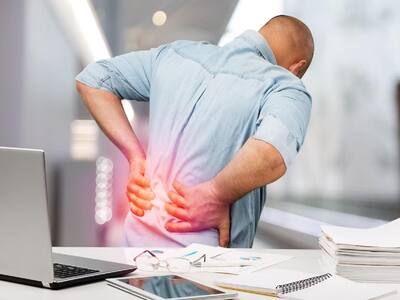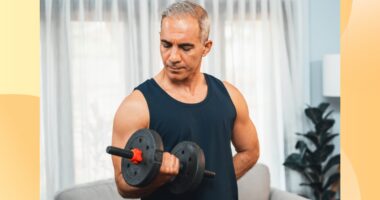
Treatment for low back pain varies depending on the cause and severity. Know when one may need spinal surgery for low back pain.
Have you ever felt a dull and achy pain while sitting in your chair all day working? You’re not alone. Many people experience low back pain, and the causes can vary from person to person. The low back is made up of important structures that are crucial to understand when trying to figure out the source of the pain. These structures include five vertebral bodies, intervertebral discs, nerves, adjacent joints, muscles, as well as blood vessels and ligaments. Low back pain is a common problem that affects people of all ages and backgrounds. The pain can be acute, starting suddenly, or it can be chronic, lasting for a long time.
Talking to the HealthSite, Dr. Abhilash Bansal, Senior Consultant Neurosurgeon and Spine Surgeon, SPARSH Hospital, explained the causes of low back pain and available treatment options. He also busted some myths about spine surgery. Excerpts follow:
Q. What causes lower back pain?
- Herniated Discs: Also known as slipped disc or prolapsed disc, this occurs when the intervertebral discs in the spine bulge or rupture.
- Spinal Stenosis: The narrowing of the space within the spine can lead to the compression of nerves, causing low back pain.
- Spondylolisthesis: This condition involves one vertebra slipping over the adjacent vertebra, resulting in neural compression and subsequent pain.
- Musculoskeletal Issues: Commonly in the form of muscle strain, ligament sprain, or joint dysfunction, these problems can contribute to low back pain.
Infections, tumors, and fractures are additional reasons that can cause low back ache.
Q. What makes one prone to developing low back pain?
- Age: As we age, the joints in our spine undergo wear and tear, commonly referred to as spondylosis. Younger individuals may experience back pain due to factors like poor posture and repetitive heavy lifting.
- Sedentary Lifestyle: A lack of physical activity weakens the core muscles responsible for maintaining proper posture and the integrity of the vertebral column. This can contribute to back pain, making core muscle strengthening exercises essential for treatment.
- Poor Posture: With the rise of digitization and work-from-home culture, poor sitting posture has emerged as a significant cause of back pain. Prolonged periods of sitting in one position and inadequate ergonomic support from chairs can exacerbate backaches.
- Obesity: Excess weight places additional stress on the joints, including those in the back, leading to increased back pain.
- Smoking: Nicotine, found in cigarettes, restricts blood flow to spinal structures, resulting in degeneration and pain. Furthermore, smoking has been linked to delayed healing of the spine after surgery.
Q. How is low back pain diagnosed?
Listening to the patient’s history: Carefully listening to the patient’s account helps identify potential causes of back pain. Past history of falls, physical stress, or activities like sports and gymnastics provide valuable clues. Leg pain caused by reduced blood flow can mimic back pain, and patient history aids in accurate diagnosis.
Physical Examination: A thorough head-to-toe examination is crucial to narrow down possible causes of back pain. Abnormalities, such as developmental or genetically inherited tumors or spinal deformities, can be detected during the examination.
Imaging: After history taking and examination, the spine surgeon determines which region of the spine requires imaging for a definitive diagnosis. MRI scan of the lumbar spine is commonly ordered to assess nerves, muscles, discs, and vertebrae alignment.
Bone Mineral Densitometry: This test evaluates bone quality and aids in decision-making for certain aspects of spine surgery.
Nerve Conduction Studies: MRI scans and X-rays provide information about the spine, while nerve conduction studies assess nerve health and function. They are useful when there is doubt about pain originating from peripheral nerves.
Q. What are the treatment options for low back pain?
Treatment for low back pain varies depending on the cause and severity. Options include self-care measures such as rest and painkillers for acute muscular pain, personalized exercise programs through physical therapy to improve flexibility and strength, medications like anti-inflammatories and muscle relaxants for severe pain, localized steroid injections to avoid systemic side effects, and surgical interventions if conservative approaches fail or if there is a risk of neurological complications.
Q. When does one need spinal surgery for low back pain?
Spine surgery may be necessary in cases where spine-related pain persists despite lifestyle changes and conservative treatment. It is also considered when spine ailments are accompanied by weakness and numbness in body parts, impending neurological deficits, difficulty in urination, imbalance while walking, progressive difficulty in walking, or pain radiating to the lower limbs
Surgical options for low back pain include lumbar laminectomy, which involves removing bone pieces to relieve nerve compression in cases of spinal stenosis. Microdiscectomy removes lumbar discs causing nerve compression, often combined with laminectomy. Spinal fusion stabilizes the spine using screws, while minimally invasive techniques are suitable for selected patients. Vertebroplasty and kyphoplasty inject bone cement into fractured vertebrae in osteoporosis.
Spine surgery can be classified as an emergency in certain situations. These include sudden onset of limb weakness, inability to pass urine, sudden onset of erectile dysfunction, and spinal fractures. In such cases, immediate surgical intervention may be necessary to address the urgent and potentially life-threatening complications associated with these conditions.
READ RELATED: 7 Fast-Food Chains That Serve the Best Steak Sandwiches
Myths about spine surgery that people should stop believing
Myth 1: All spine surgeries are long and major surgeries.
The spine is a complex organ. Operating on the spine requires expertise, technology and patience. For best outcomes, we believe slow surgeries are the best surgeries. However, with the invention of latest technologies, the duration has been reduced significantly without compromising on the outcomes.
Myth 2: Spine Surgeon will always advise surgery.
This is not correct. Spine specialist is one who knows best when not to operate. A spine surgeon always knows the biomechanics and intricacies of the spinal procedures. Spine surgeons always try to manage the spine condition conservatively lest there is an imminent threat to neural structures causing weakness of limbs or other neurological deficits.
Myth 3: Recovery from Spine surgery is unbearably painful.
Every surgery carries pain as the outcome. With advances in medical science and drugs, the pain can be adequately controlled.
Myth 4: It takes a long time to recover from spine surgery.
Recent techniques like minimally invasive procedures and endoscopic spine surgery, the recovery period is considerably reduced as compared to older days.
Myth 5: There are a lot of restrictions in activities of daily living after spine surgeries.
Operating on the spine provides an opportunity to reinstate the quality of life. Post procedure period aims at rehabilitation and return to normal lifestyle. However few lifestyle modifications are desired to take care of the rest of the spine.
Total Wellness is now just a click away.
Follow us on
window.addEventListener(‘load’, (event) => {
// $(document).ready(function(){
$(‘#commentbtn’).on(“click”,function(){
(function(d, s, id) { var js, fjs = d.getElementsByTagName(s)[0]; if (d.getElementById(id)) return; js = d.createElement(s); js.id = id; js.src = “//connect.facebook.net/en_US/sdk.js#xfbml=1&version=v2.3”; fjs.parentNode.insertBefore(js, fjs);}(document, ‘script’, ‘facebook-jssdk’));
$(“.cmntbox”).toggle();
});
// });
});






